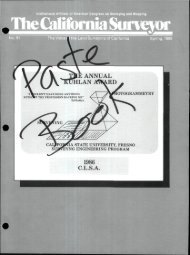P - CLSA
P - CLSA
P - CLSA
Create successful ePaper yourself
Turn your PDF publications into a flip-book with our unique Google optimized e-Paper software.
m<br />
VARIED FORCES<br />
(Continued from page 23)<br />
It may be viewed to some extent<br />
much as an egg.<br />
The idea is to select an ellipsoid<br />
hat nearly approximates the size<br />
nd shape of the geoid. A line<br />
perpendicular to the surface of the<br />
ellipsoid is called a normal.<br />
Obviously a perfect geoid-ellipsoid<br />
fit would have all points at<br />
equal elevation and the perpendicular<br />
lines at a point would coincide.<br />
The physical reaUty of the geoid<br />
makes this an impossibility.<br />
The elevation difference is termed<br />
geoid separation while the directional<br />
difference is the deflection of<br />
the vertical.<br />
The surface of an elUpsoid of revolution,<br />
which is usually referred to<br />
as a spheroid, may be defined precisely,<br />
and the relative location of<br />
points upon its surface are easily<br />
computed.<br />
In earlier days, computation was<br />
done by hand with logarithms or<br />
natural trig functions with intermediate<br />
steps tabulated on printed<br />
forms. With electronic computers<br />
such calculations are virtually instantaneous.<br />
Because the multi-curved surface<br />
of the spheroid is not easily correctable<br />
into a plane surface for production<br />
of maps, an auxiliary surface<br />
with a surface curved in only one<br />
direction, e.g., a cylinder or a cone,<br />
is often introduced. Such a surface<br />
may then be flattened without excessive<br />
distortion along the axis and<br />
is easily computed on by non-geodetic<br />
methods in terms of plane<br />
coordinates.<br />
The land surveyor generally performs<br />
plane surveying, in most<br />
cases, assuming a plane touching<br />
the topographic surface, but<br />
oriented by the force of gravity. He<br />
uses a large number of planes, with<br />
a new plane at each instrument station,<br />
and each considered tangent at<br />
the station. In a small area, the<br />
assumption of a single plane is<br />
reasonably valid, especially when<br />
the observational errors are much<br />
greater than the errors in the<br />
assumption. However, when working<br />
within a larger area and using<br />
today's information, errors of the<br />
assumption can become evident as<br />
failure of control to close upon itself.<br />
Consider a 10 mile square to be<br />
traversed, three corners having an<br />
average elevation of 400 feet and<br />
the northwest comer quickly rising<br />
to about 1,100 feet, with traverse<br />
line lengths of about one mile. Lone<br />
lengths reduced to horizontal will<br />
have an average elevation of about<br />
400 feet except for the last mile on<br />
west side and the first mile north<br />
side. These will have an average<br />
elevation of about 770 feet. Failure<br />
to consider the difference in sea<br />
level reduction on just two lines can<br />
cause an error of about 0.20 feet, a<br />
not immeasurable difference with<br />
today's equipment.<br />
Similarly, the plane of the<br />
traverse station at one of the corners<br />
will be about 170 feet below the<br />
plane at the diametrically opposed<br />
station and the vertical will be out<br />
of parallel about 14 minutes of arc.<br />
Failure to consider the earth's curvature<br />
and convergence of meridians<br />
can account for probably<br />
another 0.2 feet of failure to close.<br />
Obviously when working on a larger<br />
systems of local orientation, problems<br />
get progressively worse. But<br />
now consider typing two systems<br />
together.<br />
Our assumptions of the local system<br />
and plane surveying has its<br />
merits under some circumstances,<br />
but, because of the physical reality,<br />
there may well be times we will<br />
want to consider other alternatives.<br />
D<br />
P<br />
CIVIlSOFr" CONTOUR<br />
Why be limited by your software? CONTOUR is a fast, flexible and<br />
accurate contour plotting program that was designed considering the<br />
needs of over 4,000 CIVILSOFT users.<br />
FMST<br />
CONTOUR is fast. Calculations are performed quickly. Take advantage<br />
of an 8087 or 80287 math co-processor and watch CONTOUR run<br />
even faster.<br />
FLEXIBLE Dm INPUT<br />
Look at data from two graphic viewpoints: the familiar two-dimensional<br />
representation or a three-dimensional mesh. Input data a number of<br />
different ways:<br />
• from COGO-80/86,COGO-PC, or DIGIPLUS<br />
• directly from the field or supported data collectors<br />
• from existing maps<br />
• from existing files<br />
• from your own programs<br />
Of course, data can still be entered from the keyboard, the only option<br />
many other programs give you. CONTOUR can also produce the standard<br />
CONTOUR map in AutoCAD format.<br />
MCCUBXTE<br />
CONTOUR uses the TIN method of triangulated irregular networks<br />
for calculations. It can easily describe abrupt drops like curbs or cliffs.<br />
CONTOUR finds the best solution for any type of data.<br />
HARDWARE INDEPENDENCE<br />
CONTOUR supports over 30 high resolution color or monochrome<br />
adapters and displays, and over 15 different models of plotters,<br />
including Hewlett-Packard, Houston Instruments and CalComp. Printer<br />
plotting to exact scale can be made on supported printers. Take a look<br />
at CONTOUR and ^_— , ^ CIVILSOFT^<br />
give us your input.<br />
1592N.Batavia St.,Suite 1-A<br />
Orange, CA 92667<br />
(714)974-1864<br />
CIVILSOFT"^ is a division of tfie Technical Group, Inc.<br />
The California Surveyor — Summer, 1986 Page 25
















